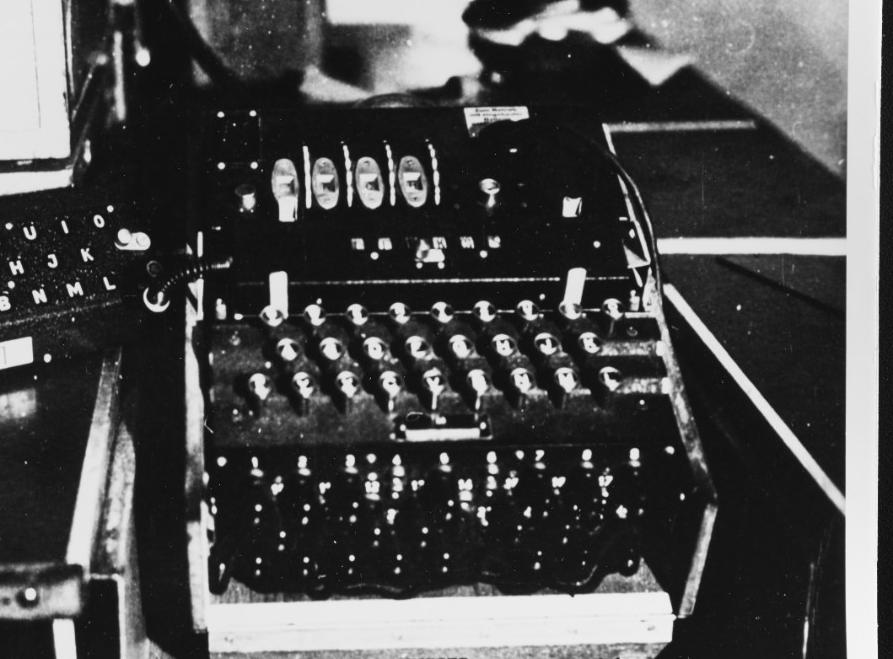
4 minute read
COVER STORY First Lady of Naval Cryptology
BREAKING THE CODE
Agnes Meyer Driscoll: First Lady of Naval Cryptology
Advertisement
Story by David “Duna” Hodge, Joint Base Pearl Harbor-Hickam Public Affairs

On board the cruiser PRINZ EUGEN, soon after V-E Day. She carried from eight to ten of these German coding machines. One of them was sent to the U.S. Navy Chief of Naval Operations by the Naval technical mission in Europe.
(Photo by Naval History and Heritage Command)
In 1917, the Navy hurried to establish its Code and Signal section in the Office of Naval Communications toward the end of World War I. In 1942, Cmdr. Joe Rochefort’s efforts at Pearl Harbor’s Station Hypo cracked the code that enabled the Navy’s success against the Imperial Japanese Navy at the Battle of Midway. But who carried the torch of Naval Cryptology between those years? Who taught Rochefort and many others how to break code?
Described as a first-class cryptanalyst, Agnes May Meyer Driscoll’s work gained her the reputation as a master code breaker. Looking back, many consider her to have been the “First Lady of Naval Cryptology.” Born in Geneseo, Illinois on July 24, 1889, Agnes May Meyer was the third of eight children born to German immigrant Dr. Gustave Frederick Meyer and Lucy Andrews Shaw Meyer. She received a Bachelor of Arts Degree in 1911, majoring in mathematics and physics, with strong minors in foreign languages and music. After graduating she moved over 1,000 miles away to Amarillo, Texas, and was director of music at a military academy. She later taught math and chaired the math department at Amarillo High School.
Meyer enlisted in the Naval Reserves as a Yeoman First Class in 1918, a year after the Navy began accepting women into clerical positions. She reported to the Navy Yard in Washington, DC as a Yeoman, and eventually transferred to the Code and Signal section for research work in code and ciphers. She remained on active duty until 1919, leaving the reserves in 1920, as a chief petty officer – the highest rank for women at that time.
After her discharge, the Navy immediately hired Meyer as a clerk in the Office of the Director of Naval Communications. She studied cryptanalysis in New York City and Chicago and showed remarkable talent for the cryptology field. After two years in private industry at Hebern Electric Code Company and her marriage to Michael Bernard Driscoll, Agnes would again work for the Navy as a cryptanalyst beginning in 1924.
As a woman in a field overshadowed by men, she took charge of decoding the Japanese fleet codebook known as the “Red National Book,” increasing the Navy’s knowledge of the Imperial Japanese Navy’s logistics, maneuvers, and advances in naval aviation. In 1931, the follow-on work she did in decoding their “Blue Book” revealed details on Japanese battleships, resulting in the redesign of the U.S. Navy’s North Carolina-class battleships. Later, just before the dawn of World War II, Driscoll realized Japan’s new “JN-25” code was machine-generated and developed the means to decode it. Again, in 1935, she led the attack on their M-1, known as the “Orange Machine.”
As innovative as her work with the Navy was, it was not limited to breaking codes or developing cipher machines. In the years leading up to World War II, perhaps using the skills from her first occupation as a teacher, she taught a succession of junior officers the art of cryptology. Many of her best students became the important cryptanalysts needed during and after the war, and those officers included Rochefort.
After the war, she worked for the Armed Forces Security Agency (later known as the National Security Agency) beginning in 1949. She would not hold the influence she had in her early days with the Navy, however.
Sometimes referred to as Madame X, and described as “forbidding” or aristocratic, she never allowed anyone to patronize her. Complicating her life was the fact Driscoll had never fully recovered from a serious auto accident in 1937. When she returned to work, those around her noticed a change in personality, becoming secretive, bitter, and even a little paranoid.
She retired in 1959 when she was 70 years old. Driscoll died without fanfare or public recognition in 1971, and was buried next to her husband in Arlington National Cemetery. In 2000, the NSA inducted Driscoll into its Hall of Honor. A final tribute to the principal pioneer of Navy cryptology.
As we remember the efforts in our nation's defense during Women's History Month, we must keep in mind the norms of society during Driscoll's early life. As Kevin Wade Johnson points out in his book, The Neglected Giant, she was not able to vote until 1920, at the age of 31. When growing up, the few women that did work generally kept to clerical, teaching, nursing or domestic careers. Even with her abilities, she undoubtedly faced sexism, and was promoted in grade only three times in her career. One of the originals, Johnson writes "...she towers above nearly all her contemporaries." Despite any imperfections, Agnes May Meyer Driscoll was indeed the "First Lady of Naval Cryptology."

Arrest of German spy by federal authorities revealed a startling plot to blow up ammunition ships leaving port off New York. Suitcases removed from the rooms occupied by Robert Fay and his brother-in-law Walter L. Scholz, the alleged spy and conspirator, which were filled with explosives, U.S. survey maps, and an atlas.
(Photo by Naval History and Heritage Command)





